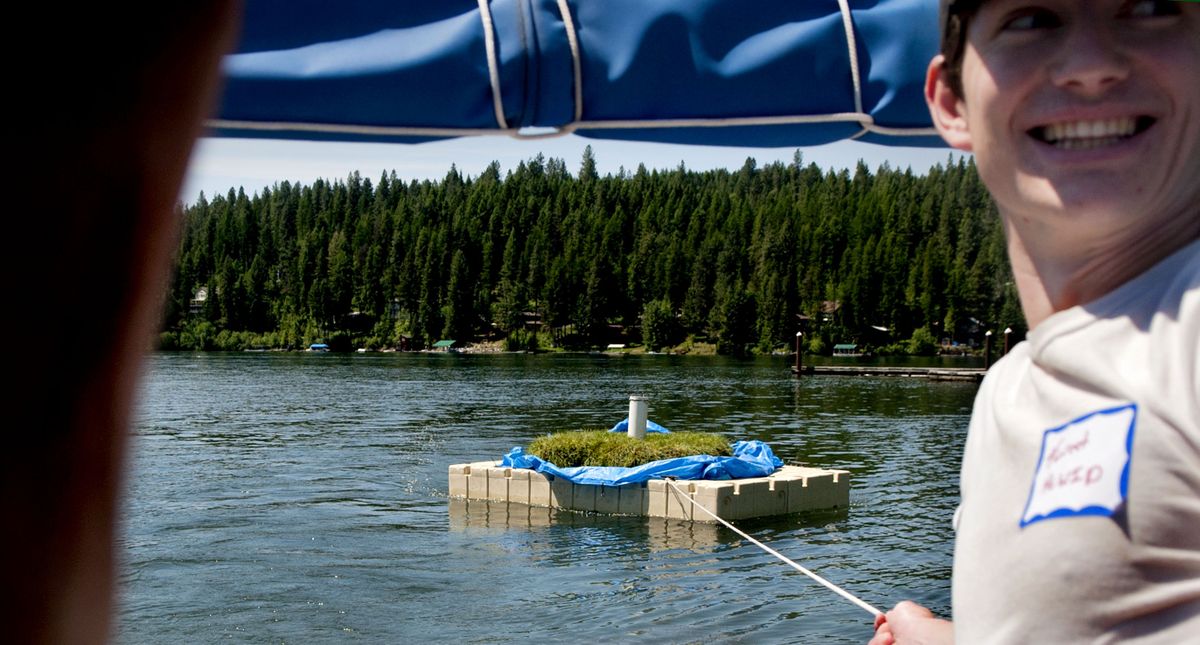Hayden Lake’s floating wetlands aimed at reducing phosphorus pollution
Forrest Walker of Hayden Lake Watershed Improvement District holds onto a floating wetland as it is towed to a bay in the northeast corner of Hayden Lake on Friday. Kootenai Environmental Alliance is launching eight floating wetlands in bays around Hayden Lake this year. (Kathy Plonka)Buy a print of this photo
Blue-green algae blooms can turn the bay near Tim and Betty Howell’s house from picturesque to yucky.
When the water quality deteriorates, the blooms appear in the shallow bay at the north end of Hayden Lake, coating the water with scum.
“It literally looks like somebody poured paint into the bay,” Tim Howell said.
This summer, the Howells hope to see the bay remain algae-free. They’re one of eight Hayden Lake property owners who volunteered to have a man-made, floating wetland installed near their dock.
The wetlands, made out of plastic membranes, are planted with flowers, sedges and rushes that grow hydroponically, sucking phosphorus and other nutrients out of the lake.
The $23,000 project will test how effective the wetlands are at improving Hayden Lake’s water quality. If the project is successful, it could become a prototype for other lakes in the region.
“Hayden is just one of the lakes showing signs of nutrient problems,” said Adrienne Cronebaugh, Kootenai Environmental Alliance’s executive director. “The water is getting murkier … in a lot of the lakes that we love.”
KEA piloted the use of floating wetlands in Hayden Lake four years ago. The wetlands, which are made by Floating Island International of Montana, are actually designed for use in sewage treatment ponds. There’s a lot of interest in how they’ll perform in lakes.
“We want to see if they can do the same type of water-quality treatment in a natural lake system,” said Kristin Larson, a watershed coordinator for the Idaho Department of Environmental Quality.
The Hayden Area Regional Sewer Board is putting up the money to expand the number of floating wetlands in Hayden Lake and to pay University of Idaho researchers to study how well the wetlands work. The $23,000 was part of a settlement with Idaho DEQ over the delayed reporting of a 2004 spill at the Hayden treatment plant.
“It’s a great project for the lake,” said Ken Windram, the sewer board’s general manager. “We wanted to invest in something with real benefits for the community.”
Hayden Lake has failed to meet federal water quality standards for phosphorus since the late 1990s. Nutrients enter the lake through a variety of ways, including septic tanks, sediment from logging roads and development around the lake.
The most severe water quality problems occur on Hayden Lake’s northern end, where pasture land was flooded decades ago to raise the lake level.
KEA’s Cronebaugh sees the floating wetlands as a partial solution to the lake’s problems.
“Our vision is having a small one attached to each dock, so we’ll get a cumulative effect on water quality,” she said.
On Friday morning, crews prepared four floating wetlands for bays on Hayden Lake’s northern edge. The membranes were covered with sod and then planted with native rushes, sedges and yellow-blooming monkey flowers.
The plants were chosen for their nutrient uptake. Monkey flowers, in particular, have an enormous appetite for phosphorus and they can tolerate having their roots submerged, said Mark Shumar, a botanist with Idaho DEQ.
The floating wetlands are designed to mimic nature. In addition to the plants growing on the surface, fish are attracted to the submerged portion of the wetland and bacteria colonize there, taking up nutrients, Cronebaugh said.
The floating island will be monitored in mid-summer and in fall to determine how much phosphorus the plants have consumed.
Four floating wetlands will also be installed in bays on Hayden Lake’s south shoreline as a control group.
Tim Howell, the property owner, is excited about the wetlands’ potential.
Since he and his wife moved into their home three years ago, the bay near their house has experienced multiple blue-green algae outbreaks. The couple’s golden Lab, who loves the water, has to be on a leash during outbreaks because toxins from the algae can be fatal to pets.
“I couldn’t agree fast enough to put one of these things in the bay,” Howell said. “I hope the science and information coming out of this will benefit the whole lake.”

